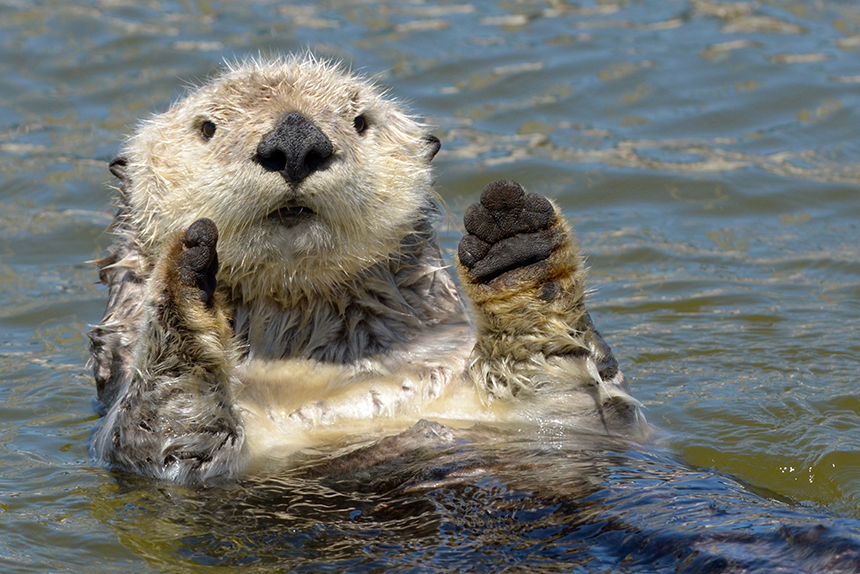By FRANK CARINI/ecoRI News staff
 |
| Todd McLeish’s latest book takes a deep dive into the life and times of sea otters. (Michael Yang) |
His criteria also include writing about species that are threatened or endangered.
“I have to find an animal that I want to spend five years of my
life with,” Todd McLeish told ecoRI News on March 20, the day his most recent
book, Return of the Sea Otter: The Story
of the Animal that Evaded Extinction on the Pacific Coast, was released.
“I’ve always wanted to write about muskox, but who would want to read it? It’s hard to get people excited about an animal they’ve never heard about.”
“I’ve always wanted to write about muskox, but who would want to read it? It’s hard to get people excited about an animal they’ve never heard about.”
Sea otters don’t present that problem. The adorable, furry marine
mammals are fan favorites. Despite their popularity, however, McLeish said his
book is the first “full-blown book” about sea otters. Most books about sea
otters are children’s books, he noted.
Sea otters, often seen floating on their backs in kelp fields
dining on shellfish, reveal the improving health of the coastal ecosystem along
the Pacific Ocean.
Once hunted for their prized fur during the 18th and 19th centuries, these animals nearly disappeared like the dodo and passenger pigeon.
Once hunted for their prized fur during the 18th and 19th centuries, these animals nearly disappeared like the dodo and passenger pigeon.
Only now, about a century after hunting ceased, are populations
showing stable growth in some places. Sea otters are a keystone species in
coastal areas, feeding on sea urchins, clams, crabs and other crustaceans.
When they are present, kelp beds are thick and healthy, providing homes for an array of sea creatures. When otters disappear, sea urchins take over, and kelp disappears, along with the sea life that live in the beds.
Now, thanks to their protected status — hunting of sea otters has been banned since 1911 — these important marine mammals are making a comeback in California, Washington and Alaska.
When they are present, kelp beds are thick and healthy, providing homes for an array of sea creatures. When otters disappear, sea urchins take over, and kelp disappears, along with the sea life that live in the beds.
Now, thanks to their protected status — hunting of sea otters has been banned since 1911 — these important marine mammals are making a comeback in California, Washington and Alaska.
His third book, “Narwhals: Arctic Whales in a Melting World,” like
his latest, took him out of the friendly confines of New England. To write
about narwhals, required a trip to remote northern Greenland, an out-of-pocket
expense of $8,000.
His journeys up and down the West Coast to write about sea otters
were a tad less expensive, but no less adventurous. McLeish observed sea otter
autopsies.
He saw trackers being surgically implanted in their bodies. He sailed the coast of British Columbia with researchers counting sea otters.
He scuba dived in kelp forests off the coast of Monterey, Calif., watching sea otters at play. He visited with researchers, scientists and veterinarians at the Monterey Bay Aquarium marine mammal rehabilitation center.
He saw trackers being surgically implanted in their bodies. He sailed the coast of British Columbia with researchers counting sea otters.
He scuba dived in kelp forests off the coast of Monterey, Calif., watching sea otters at play. He visited with researchers, scientists and veterinarians at the Monterey Bay Aquarium marine mammal rehabilitation center.
McLeish got an up-close look at sea otters, both alive and dead.
“They’re bigger than people think,” he said. “They’re more than just a bunch of
fluff.”
He said sea otters can grow to be 5 feet long and weigh 100
pounds. They also have a lot of fur — a million tiny hairs per square inch.
“They have the best fur on the planet,” McLeish said. “That’s why
they were almost hunted to extinction.”
While their populations have rebounded, sea otters still have a
ways to go to get their numbers back. California’s population of sea otters,
which ranges from Santa Barbara to Carmel, is still listed as endangered.
Populations off the coasts of Washington and Alaska are doing better, but sea
otters are no longer found off the coasts of Mexico, Northern California,
Oregon and Japan.
The only people allowed to hunt sea otters now are native
Alaskans, and few actually do, according to McLeish.
There are 13 species of otters worldwide, but only two, sea otters
and river otters, can be found in North America. River otters are the only
otters you’ll see in New England. They are about half the size of sea otters,
and, unlike their marine cousins, spend ample time on land.
McLeish, a regular contributor to ecoRI News, became interested in
wildlife during his college years at Ithaca College in upstate New York, when
he took up birdwatching.
“My main interest was birds, but you slowly learn about habitat
and the other creatures sharing the space,” said McLeish, a North Kingstown native
who worked in the University of Rhode Island’s communications department for 16
years.
Today McLeish, 55, is a popular public speaker on cruise ships and at
museums and environmental centers, and has published wildlife articles in
Earthwatch Journal, Bird Watcher's Digest, WildBird, and Natural New England.
He runs a wildlife blog called The Narwhal’s Left Tooth.